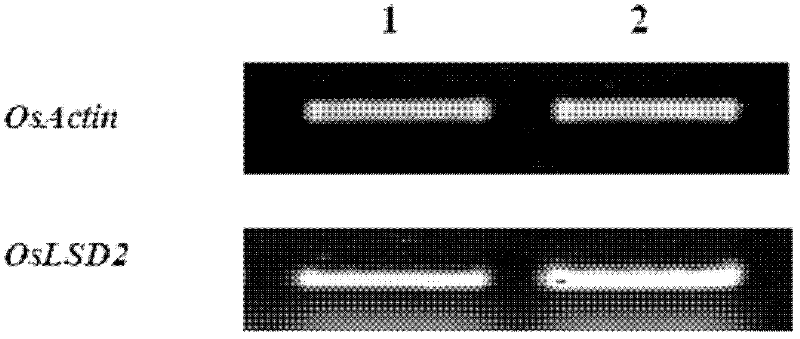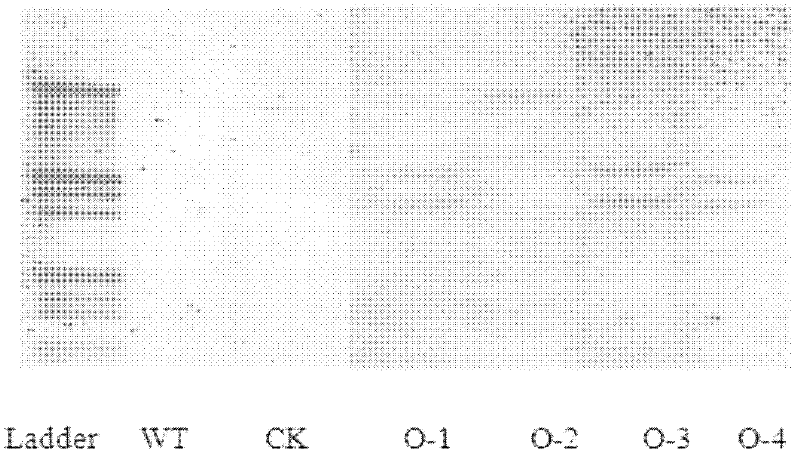Application of the key gene oslsd2 in the formation of rice aerenchyma
A technology of ventilation tissue and key genes, applied in the field of genetic engineering, can solve problems such as damage to plasma membrane integrity, and achieve the effect of improving nitrogen utilization efficiency
- Summary
- Abstract
- Description
- Claims
- Application Information
AI Technical Summary
Problems solved by technology
Method used
Image
Examples
Embodiment 1
[0022] Example 1 OsLSD2 gene (accession number is AK111759) expression characteristics in rice
[0023] 1) Extraction of total RNA The seeds of rice Wuyujing No. 7 were treated with 30% NaCLO by mass ratio 2 Sterilize, accelerate germination, and when two leaves and one heart are cultivated, select rice plants of the same size, remove the endosperm, and transplant them into 1 / 2 International Rice Research Institute IRRI nutrient solution with pH 5.5, and replace them with International Rice Research Institute IRRI nutrient solution when four leaves are one heart Complete nutrient solution (Mao D R. The methods of plant nutrition research. Beijing: Beijing Agricultural University Press, 1994.), after culturing for one week, the roots and leaves were quickly placed in liquid nitrogen for frozen storage, and about 0.1 g of samples were weighed. Grind with liquid nitrogen, grind thoroughly and add to a 1.5ml centrifuge tube, quickly add 1ml Trizol reagent, add 0.2mL chloroform, ab...
Embodiment 2
[0029] Overexpression plant of embodiment 2 OsLSD2 gene
[0030] 1) The extraction of total RNA is the same as in Example 1;
[0031] 2) Total cDNA synthesis is the same as in Example 1;
[0032] 3) Acquisition of full-length cDNA of OsLSD2 gene
[0033] Using the total cDNA of rice Wuyujing No. 7 obtained above as a template, PCR primers were designed. The PCR product contained the complete OsLSD2 reading frame (from the start codon ATG to the 3' non-coding region), and the primer sequence was:
[0034] OverLSD2-F: 5'-TTGAGGATCCGTGCCATTTACACCTC-3' (SEQ ID NO.5, containing BamH I restriction site)
[0035] OverLSD2-R: 5'-ATATGGTACCACAGACCTTGCGCCAT-3' (SEQ ID NO.6, containing Kpn I restriction site)
[0036] PCR 20μL system: 2μL 2.5mM dNTP, 2uL 10x PCR buffer, 1μL OverLSD2-F, 1μL OverLSD2-R, 1μL cDNA, 13μL ddH 2 O.
[0037] The PCR program is as follows: pre-denaturation at 94°C for 4 minutes, denaturation at 98°C for 10 seconds, annealing and extension at 68°C for 2 minut...
Embodiment 3
[0085] The completion of embodiment 3 root paraffin sections
[0086] Select the wild-type (Wuyujing 7) and OsLSD2 overexpression material (O-4) seedling roots (that is, the first root after seed germination) that have germinated for 5-10 days, and take them 1-1.5cm away from the root tip. , 1.5-2cm two sections of roots, prepare paraffin sections, observe the aerenchyma of the roots under a microscope, the results are shown in Figure 5 . Depend on Figure 5 It can be seen that the OsLSD2 overexpression material (O-4) has more developed root aerenchyma than the wild type (Wuyujing 7).
PUM
 Login to View More
Login to View More Abstract
Description
Claims
Application Information
 Login to View More
Login to View More - R&D
- Intellectual Property
- Life Sciences
- Materials
- Tech Scout
- Unparalleled Data Quality
- Higher Quality Content
- 60% Fewer Hallucinations
Browse by: Latest US Patents, China's latest patents, Technical Efficacy Thesaurus, Application Domain, Technology Topic, Popular Technical Reports.
© 2025 PatSnap. All rights reserved.Legal|Privacy policy|Modern Slavery Act Transparency Statement|Sitemap|About US| Contact US: help@patsnap.com



